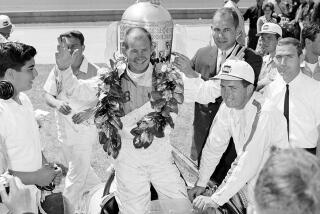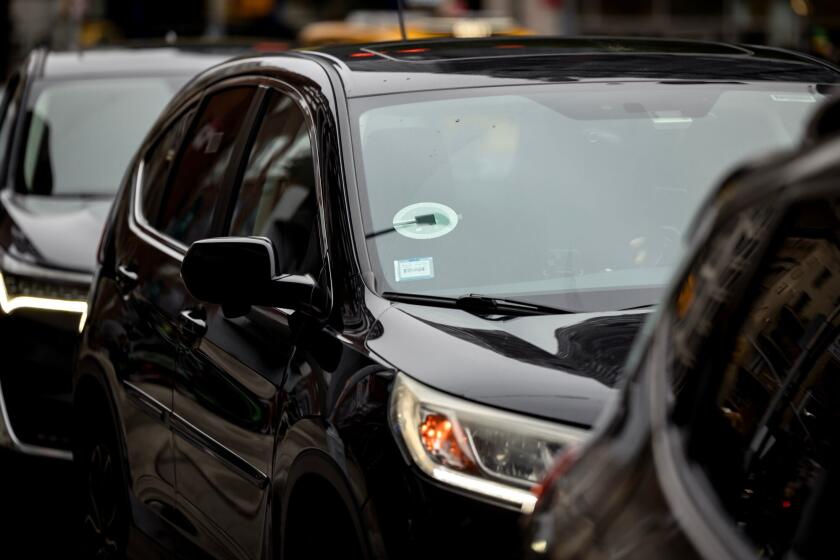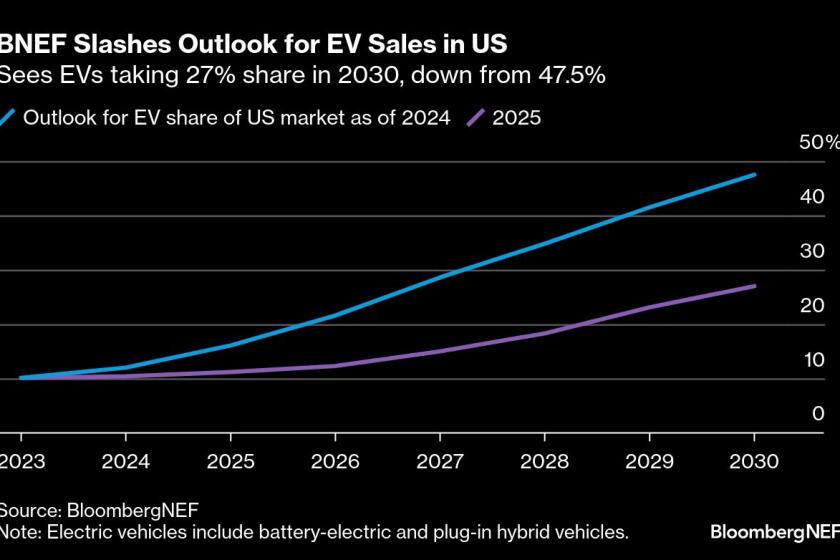At 84, legendary Shelby keeps pedal to the metal
- Share via
The rock star of the automotive industry is a Texan who speeds through life with heart and kidney transplants, precious little vision in his left eye and a crooked right arm, the souvenir of a long-ago Mexican road race in which he missed a turn and struck a boulder.
At 84, he roars around the test track at 150 mph as casually as the normal human parks the family sedan in the garage. And Carroll Shelby is still refitting Mustang convertibles and coupes to produce distinctive vehicles that bear his name.
You can see the latest in showrooms as soon as Shelby’s Las Vegas production facility puts the finishing touches on the Shelby GT. The 2,300 cars are going to sell for about $45,000 each, but the price may rise because demand is so great.
“It’s a damn good car -- the best car out there for the money right now,” Shelby said. In his mind, though, it’s not perfect, with just 340 horsepower.
“I’d like for it to have about 300 more,” he said, “but with government regulations we have to be careful about insurance rates going up.”
This baby has come a long way from the mid-1960s. That’s when old friend Lee Iacocca called, just after Shelby’s first Ford race car, the legendary Cobra, beat Ferrari and the rest of Europe’s best at Le Mans. Iacocca asked him to design a competitive Mustang. Shelby, who was living in Los Angeles and operating his thriving Shelby American plant near Los Angeles International Airport, reluctantly agreed to try.
“It was practically impossible to take a little secretary’s car that sold for $2,395 and turn it into something that would go out and win races,” Shelby recalled.
But he did it. “Ford had a V8 engine I thought we could hop up. Then I asked my friend John Bishop at Sports Car Club of America what he thought I ought to do with the chassis. He said I ought to put bigger brakes on it, take the rear seats out and change to a much stiffer suspension.”
Result: The first Shelby GT Mustang. Ford released it in mid-1965 and sold 500 or so, and buyers were delighted.
A three-time U.S. auto racing champion in the ‘50s and international headliner as well, Shelby was Sports Illustrated’s driver of the year in 1956 and ’57 and capped his competitive career by winning the Le Mans 24-hour endurance race in ‘59, driving for Aston-Martin. That’s when his heart told him it was time to quit racing -- although he was only 36 -- and pursue his foremost goal of auto design.
“My heart went south on me when I won Le Mans and I had to take about 15 nitroglycerin tablets,” he said. “That ain’t no way to drive a race car. That’s the way to a sudden finish.”
Today Shelby is something of a miracle of medical science. In 1990, at age 67, he was told he had two weeks to live before he received a heart transplant at Cedars-Sinai Medical Center. Shelby said the donor was a 34-year-old man in great shape “who dropped dead shooting craps in Las Vegas.”
“By May 1991 I was driving the pace car at the Indianapolis 500. Gen. Norman Schwarzkopf, just back from Iraq, was grand marshal and I drove him around the track once at 150 mph. Later, he found out I’d had a heart transplant. He said, ‘I had a couple of close calls in Desert Storm but nothing like that ride.’ ”
(In October 1991, Shelby made good on a pledge he’d made to “put enough back in,” after seeing kids die on either side of him in intensive care. He founded the Carroll Shelby Children’s Foundation, which has raised millions of dollars to help children with acute coronary and kidney needs. The foundation, bolstered by hundreds of thousands of dollars donated by fans after auctioning off their classic Cobras and Mustangs, sends Shelby’s surgeon, Dr. Alfredo Trento, on an annual two-week trip to treat desperately ill children in South America.)
Shelby has another donor in son Mike, who in ’96 gave his dad a kidney. Mike Shelby, a Dallas oilman, is 60 and marvels at his father’s energy.
“He has always kept a schedule that would exhaust me,” Mike said.
Shelby never has been bored. Besides racing and designing about 140 vehicles, his pursuits include flying planes, hunting elephants in Africa, farming chickens, inventing, breeding exotic cattle, cooking and overseeing a couple of dozen businesses as chairman of Carroll Shelby International.
A five-star chili fanatic, he was one of the founders of the famed Terlingua International Chili Championship in the Big Bend country of West Texas.
Shelby and Dallas attorney David Witts had bought 150,000 acres and a ghost town, and in ’67 they were trying to sell the whole spread.
“Dave went to Tom Tierney, who had done PR for Ford in Dallas, and Tom came up with the chili cook-off,” Shelby said. “We had H. Allen Smith [author-humorist] and Wick Fowler [veteran journalist and chili buff] as cooks. Frank X. Tolbert of the Dallas Morning News [author of ‘A Bowl of Red’] got involved and did a great job for us. But we had 300 press people there. That’s the kind of PR guy Tom Tierney was.
“Everybody stayed in this ol’ ranch house for three days. All it was was an adult Woodstock. I had to send my DC-3 to El Paso twice to load up with booze,” Shelby said.
Shelby and his fifth wife, Cleo, live in three homes in the U.S. Their Los Angeles residence sits on a Bel-Air hilltop with views of downtown, Catalina Island, Mt. Baldy, Long Beach and the basin. They also have a home in Las Vegas, but he considers their permanent residence to be his East Texas ranch at Pittsburg, just down the road from tiny Leesburg, “where I started and probably where I’ll end up.”
And where his eternal love of speed began.
“As a small boy I rode with my dad in his 1928 Whippet on dusty East Texas roads while he delivered his rural mail route. I’d stand on the floorboard on the right so I could see through the windshield. I’d yell, ‘Let’s go faster, Daddy!’ ”
The Shelbys moved to Dallas when Carroll was 7 and his father became a clerk at the downtown post office. “I got my driver’s license when I was 14 and one day I took my dad to work in his ’34 Plymouth. Going home I got caught doing 80 mph. That was the end of my driving for about six months.”
Once Carroll entered Woodrow Wilson High School, the action really kicked in. He so treasures his memories of friends and adventures there that he still returns to East Dallas for reunions.
“We had a lot of fun racing in Lakewood,” an upscale neighborhood in Dallas across the railroad tracks from the small frame house where the Shelbys lived. “I drove my dad’s ’38 Willys, the Lakewood guys their new Ford convertibles, and we had to race flat out down Abrams Road and cross Gaston Avenue going 60 mph. It’s a wonder we didn’t get killed.”
He survived and became one of the world’s best race drivers. But he always thought of designing cars someday.
“In the early ‘50s, I saw those European cars come over here with little four-cylinder engines and great chassis. I thought you could put an American V8 in the same hole. The Europeans put those little engines in there because gasoline was three or four dollars a gallon over there right after the war.”
When Ford Motor Co. hired him in the early ‘60s, he put his theory to work.
“Ford had a new little V8 engine, so I said, ‘If you’ll give me a few engines and some money, I’ll build you a car you can be proud of.’ ”
And the Cobra, his most famous car, was born. Today there are some 200 Shelby Cobra Clubs across the world. There also are lots of guys and gals in their 30s or early 40s named Shelby because their parents owned a Cobra.
Shelby plans to start another Cobra era soon. Besides a new car, he wants to launch Cobra Foods in a plant near his East Texas ranch. “We’ll make Cobra chili and a lot of sugar-free and health foods. Same situation as Paul Newman’s salad dressings. The money will go to charities.”
There’s always something. Asked to name the most exciting experience of his life, he answered: “Tomorrow.”






